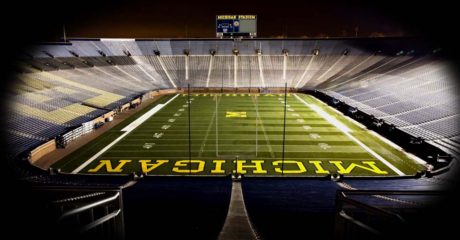Mailbag: What position will Shallman play?
So, I know that coaches have told Shallman he is going to get a shot at FB or RB in college, but he is getting to be a very big boy for that. He is already two or more inches bigger than former NFL back Mike Alstott and already 20 pounds heavier than former NFLer John Riggins. Most FBs are 5’10”-6’1″; much over that is not good for FBs, right? His frame is going to add a lot in S&C. What are your odds he becomes Ryan Van Bergen II? Would people feel better about this recruiting class if we looked at Wyatt as a DL and not as a FB? I kinda think he would be wasted as a situational offensive player.
Well, I sort of answered this question in my scouting report of Wyatt Shallman from this past winter, but I didn’t talk about this aspect in great depth.
First of all, I wouldn’t really worry about how Shallman compares to John Riggins. Riggins played from 1971 to 1985, so he was retired for a decade before Shallman was even born. Players are bigger and faster than they were then. There are guys like Michael Turner (5’10”, 247 lbs.), Steven Jackson (6’2″, 240 lbs.), and Brandon Jacobs (6’4″, 264 lbs.) running amok in the NFL these days, and each of those guys is heavier and/or taller than Riggins.
I am not the world’s biggest fan Shallman’s abilities. He doesn’t have the suddenness of an elite running back, he doesn’t have great speed, and he doesn’t break enough tackles to satisfy me. What he does offer is a differing set of skills from any other running back on the roster or in the 2013 recruiting class. With the offensive line Michigan is building, the Wolverines should be plowing over people in a couple years the way Wisconsin has been for the past several seasons. Shallman is a poor man’s Ron Dayne, P.J. Hill, Montee Ball, etc. This past Saturday night, I watched Oregon tight end Colt Lyerla (6’5″, 246 lbs.) line up in the backfield and carry the ball 7 times for 63 yards against Arizona. Players of lots of different shapes and sizes can run the ball in college.
As for Shallman’s size, there have been suggestions that he’s not quite 6’3″ or 6’4″ and that he’s not 255 lbs. He doesn’t look 255 to me; I might buy 235. Recruiting weights are often overreported, whether it’s innocent exaggeration or someone trying to beef up his own measurements to garner more attention. Several guys in Michigan’s 2012 recruiting class showed up to campus weighing less than was reported on Rivals or Scout.
The coaching staff seems to have been pretty honest with recruits about their future positions. They would rather have guys playing positions they want to play than to have to shoehorn guys into positions they dislike. Guys will play harder for you that way. The coaches have promised Shallman a shot at running back, and I think that’s where he’ll stay. There’s always a chance that somebody will change positions, but it doesn’t seem to be Brady Hoke’s M.O. to bring guys in and then turn their world upside down. Guys like Jordan Paskorz and Ricardo Miller have changed positions, but Hoke didn’t recruit them. Gardner is making a temporary (or permanent) switch to wide receiver, but again, Hoke never recruited him.
Van Bergen was an athletic guy coming out of high school, but he was clearly headed for the defensive line and never had any delusions otherwise. He had the frame to add significant weight, and he ended up at almost 290 lbs. Even if Shallman adds mass, he will likely still be 6’3″. That’s relatively short for a strongside end and he could struggle to get his hands on offensive linemen before they get into him. Meanwhile, unless he makes a concerted effort to beef up, he looks like a guy who could play his college career at 250-ish pounds.
On top of all that, I was not impressed with Shallman’s high school highlights. Word is that he was suffering from some nagging injuries last season, but I don’t see a high level of effort and determination on the defensive side of the ball. Some guys are equally adept at playing football on both sides; other guys have “it” on one side or the other. Shallman’s “it” factor seems higher on offense than defense; he’s a fine high school defender, but comparing their high school film, I would take Ryan Van Bergen on defense over Wyatt Shallman.
What are the chances Shallman plays defensive end in his college career? Eh, I’ll go with 15%, just because injuries and attrition and random things happen. But what are the chances Shallman becomes the next Ryan Van Bergen (a borderline NFL draft pick at defensive end)? I’d say that’s closer to 5%.



